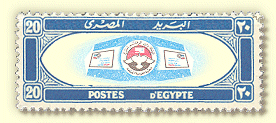

The classification system for Egyptian postal markings adopted by the Egypt Study Circle was developed by R. Seymour Blomfield and revised on occasions with help and advice from other members of the Circles1. In the following treatment the defining features of each 'Type are given along with the illustrations, which are mostly taken from tracings by Blomfield2 (a few are by C.W. Minett, A. Schmidt, or myself). These are shown in most major variants, but the offices at which each is recorded to have been used are listed only for Types I to VII, X and XI, thus including all of the classic period and a little beyond. Beginning in the late 19th century the number of post offices increased enormously. Thus it is not feasible to show all offices for the over 600 postmark Types that Blomfield catalogued. Indeed, no serious study has ever been published that correlated Types VIII, IX, and later with the offices using them. Some categories of postmarks are treated elsewhere in this book: the Napoleonic Post in Chapter I, the Courier Post of Mohammed All in Chapter III, the Posta Europea in Chapter IV, the several foreign offices in Chapters VI to XI, postage due in Chapter XXIV, express postmarks in Chapter XXVI, hotel post offices in Chapter XXV11I, military mails in Chapter XXXI, maritime mails in Chapter XXXII, Suez Canal Company in Chapter XXXV, travelling post offices in Chapter XXXVII, Sinai in Chapter XLIV, and Palestine in Chapter XLV. (Further fragments of postmark information are also to be found in other chapters.) The Types of the general-purpose date-stamps Types I to VII are defined in terms of the kind of inscription and major ancillary, features. They are numbered in chronological order of the earliest example of each Type. The secondary, features of each Type (i.e., sub-types) are defined according to kind, number, and arrangement of the indicia inside, and in some cases the typeface used for the inscription or the name of the office. The numbers are assigned on a consistent basis, the simplest and shortest arrangements being given the lowest numbers. Thus sub-types with the year in two ciphers come before those with it in four ciphers and those with only, day, month, year come before those that have a time indication as well. Date-stamps that were modified (usually b) removal of part of the inscription) are listed as sub-types of the main Type from which they were derived. The later Types have a very large number of sub-types, which were given numbers by Blomfield more or less in the order in which the first example was discovered. A transition from a format with the Arabic name at the bottom to one with the Arabic at the top took place during the reign of King Fuad. Although there is active consideration of revising the later Type designations according to a rational scheme, such an alternative has not yet been accepted by the Egypt Study Circle. If the Blomfield system should be superseded, the successor can be expected to be immediately recognizable as new and different, and there should therefore be no confusion Type I Date-stamps inscribed POSTE VICE REALI EGIZIANE (however, most circular handstamtps without date are listed in the Postal Service category) (Fig. 1). This Type was introduced in April 1865, after the Egyptian Government acquired the Posta Europea, and was used into 1870, in some cases as late as 1875. The one instance of alteration by- removing VICE REALI, Tell el Baroud, occurred posthumously (MR 1877-AP 1880) presumably as an emergency measure. 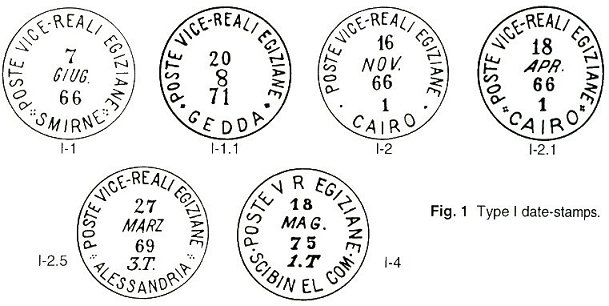 Date-stamps inscribed REGIE POSTS EGIZIANE (excluding the seal markings, which are without date) (Fig. 2). This Type was introduced in October 1867. Its use at most offices ended in June or July 1869 when the word REGIE was removed. The Sultan of Turkey perceived the use of the word regie to be an unwarranted pretension of royalty on the part of the Egyptian Viceroy4 Although the Postmaster General explained that such was not the implication of the Italian word, he immediately ordered that its use be abandoned and that the word be removed from the existing date-stamps. The altered version of the date-stamps had a very short life for most offices, being last used in January 1870 (at Suakin, it lingered until 1872 and it was erratically resurrected at Alexandria as late as April 1873). The double-circle Type, II-5, is known only for Dardanelli and Kilometro 83, from August 1869; it lasted until April 1880 at the former, but only until October 1869 at the latter office, which was closed down (the original form of these date-stamps with REGIE present was apparently never put in use). 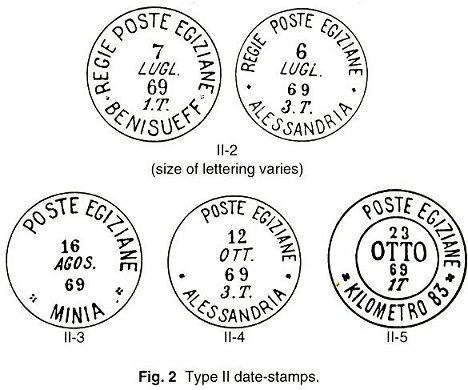 Date-stamps inscribed V.R. POSTS EGIZIANE (these are all of smaller diameter than Type I) (Fig. 3). This Type succeeded the altered Type II, and came into use in December 1869. Including the various sub-types, it remained in use until mid-1881. Only a few offices later altered it by removing V.R., in late 1875.Fig. 3 Type III date-stamps. 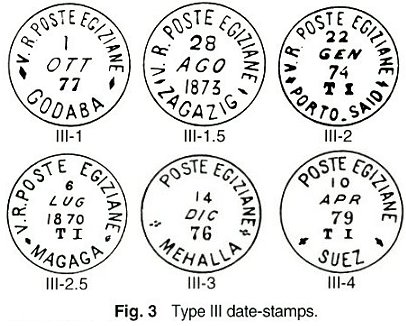 Date-stamps inscribed POSTE KHEDEUIE EGIZIANE (Fig. 4) (Type IV-6 have no date, but are included because it was the general-purpose cancellation for the offices to which it was supplied).This Type is known from April 1871 until May 1880 but was used at only a limited number of offices, some of which also had Type III and Type V date-stamps in use in the same period. Types IV-4 and IV-6 were issued only to offices in Upper Egypt and the Sudan, and are known5 used from October 1873 to mid-1874 when they were superseded by Type V-4. Examples are especially scarce to rare. 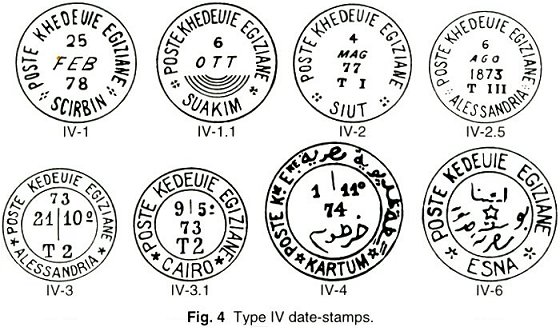 The simplified inscription, POSTE EGIZIANE, characterizes this Type (Fig. 5). It began to appear in March 1873 and has been recorded as late as June 1880. It was not supplied to all offices. Type V-4 is of particular interest, because it is bilingual4; the office name is given in Arabic and Italian, and the date entirely in Arabic. It was issued only to offices in Upper Egypt and the Sudan, where knowledge of European languages was rare. It apparently superseded Types IV-4 and IV-6 in mid-1874 and continued in use at some offices as late as December 1884 (the second cipher of the year was altered in manuscript after 1880, the die remaining fixed). It should be noted that every office known for Type V-4 had a device of identical size, but the spacing of the lettering varied according to the length of the name. (These remarks are necessary because of contrary or misleading information in other publications.)  Type VI6 The French inscription POSTES EGYPTIENNES characterizes this Type (Fig. 6). It is known only for Alexandria, Helouan, Roda, and Suez. It marks the changeover from Italian to French as the language of the Post Office, beginning with the appointment of Caillard Pasha as Postmaster General. Although it was introduced as early as July 1877 and examples have been recorded as late as December 1881, examples are scarce, even from Alexandria, and there must have been some practical reason for reluctance to use them. Type VI-1 is known for RODA only.Type  A further linguistic change is shown by this Type, in which both Arabic and French are used, and inscriptions other than the name of the office are omitted (Fig. 7). This Type and the related Special Service date-stamps are the only duplex handstamps used by the Egyptian Post Office. They were used only in Alexandria and were perhaps experimental. Because they resemble British cancellations of the period they are sometimes mistakenly presumed to be markings of the British occupation of Alexandria; the fact that this Type was introduced in November 1878, four years before the military intervention, belies that assumption. 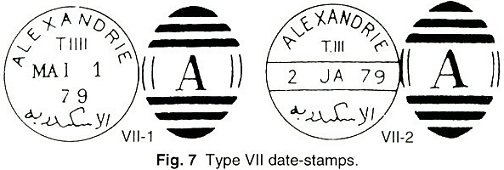 This Type was introduced about 1880, as the classic era was closing, and is characterized by the simple presence of the office name in Arabic and French, with the date in a band across the middle (Fig. 8). In its initial form, the circle is gracefully thin and the number of offices using it in that form was limited, although substantial. In later years, coarser versions came into use and the number of offices using it increased greatly. Even the original version was used in many more offices than were the early Types, but space does not allow listing those offices that were first opened in the 1880s or later. 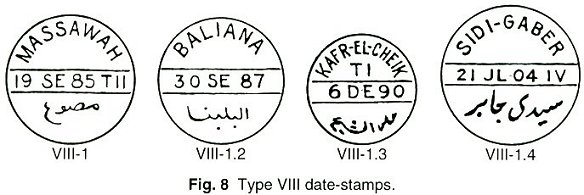 This is sometimes called the "Swiss Type" since the presence of a barred segment above and/or below the date band is characteristic of the postmarks used in Switzerland (Fig. 9). It came into use in the 1880s and was eventually issued to a large number of offices, with variations in the number and thickness of the bars. Except for the Territorial Offices in the Sudan (Chapter XXX), the offices using Type IX are not listed here (indeed, a formal study of the offices using Type IX has not been published). 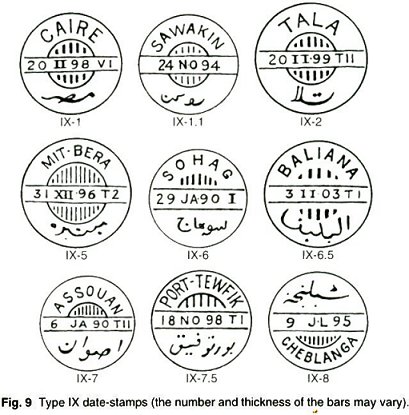 Although this Type comes just after the classic period (the earliest known use is in late-1882), its special feature of a crescent and star (Fig. 10) and the small number of offices using it give it uncommon interest. It is largely limited to a few offices in the Delta, and some east of Cairo, and four from Assouan southwards, which had involvement in the military campaign to relieve the siege of Khartoum in 1885. Although a few of them are not uncommon, some of them are among the rarest postmarks of Egypt, with but one example having been reported. The principal Type, X-1, has the office name in a curve, with a crescent and star below it (in most, a time period is indicated, `T II' etc.). Two of the offices have a compound name in two curved lines. Although nearly all offices are indicated in Arabic and European, two of them, KORTI (Sudan) and MEX / FIRST do not have the Arabic equivalent. A curious variant, Type X-3, has the office name in a straight line, with the crescent and star above it; it is known for Assouan, Dongola, and Mancabad only, used in 1884-85, and is rare. It is suspected that these offices used Type X-3 as a relief canceller at times of large influxes of troops. Some Type X postmarks went out of use as early as 1885, but a few lasted well into the 20th century, and Kosseir used Type X as late as 1919. In the following lists an asterisk indicates rarity (1 to 10 known). Types X-1
Type X-1.1
Type X-1.1
Type X-2 MEX / FIRST* Type X-3
Type XI This Type is defined by the presence of a star above the date band (Fig. 10). It was used at a small number of offices from 1907, some lasting until 19238
Type XII This type has Arabic at the top, European at the bottom, otherwise like Type VIII.  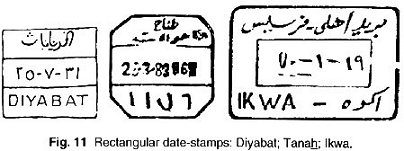 Machine Cancellations. Mechanical cancelling devices9 incorporating a circular date-stamp and an obliteration in the form of straight or wavy lines, with or without various slogans (in English, French, or Arabic) were introduced in 1922 in Alexandria and Cairo (Fig. 12). Some of the slogans publicized forthcoming special events. 1n more recent years, they have proliferated. 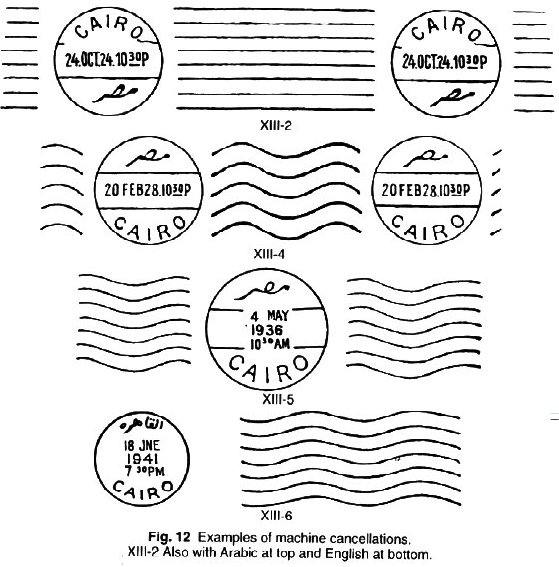 Type Tem Temporary or emergency cancellations (Fig. 13) have been resorted to occasionally. The most prominent instance is the use of the date-stamps provided by the Suez Canal Co. at locations on the Canal where Government post offices were opened in 1869 (Chapter XXXV). Another example is Khatatbe, at the western edge of the Delta, where a private company hand-stamp was used in 1880-81 immediately after tile office was first opened. Manuscript cancellations, generally with pen and ink, have been used for temporary or emergency purposes. Most of them are indecipherable. They may consist of Arabic or European writing, most commonly a date, or of crossed lines. The most important of the manuscript cancellations are those of former offices of the Suez Canal Company, applied to Second Issue stamps in 1869 immediately after the Postal Administration took them over. "Chantier VI" is the one most often seen, but all are rare. 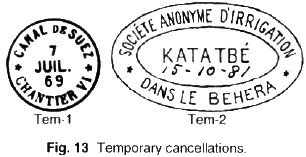 Type SL A very few offices opened in the 1870s had name handstamps of straight-line form (Fig. 14), used mostly if not entirely in the period shortly after opening. Such cancellations are rare.  Intaglio Seals Types A & R Intaglio seals with inscriptions in negative (colourless oil a solid background) (Fig. 15). They were made by carving the lettering in recess on metal or wood and were most suitable for impressing into scaling wax; the lettering was then raised. These seals were occasionally pressed into use as cancellations, especially in the first weeks after a new post office was opened, and they are also known struck on official stampless letters. When so used, the inscription appeared on tile handstarnp in negative. Since on the one hand, the recesses easily filled up with ink or dirt, and on the other hand, the large flat area of tile device was difficult to ink evenly, clearly legible impressions are the exception. The classification is based on tile alphabet used; those inscribed in Arabic lettering are designated with a prefix A, and those with Roman (Latin) lettering are designated with K. There is further subdivision according to the wording of the inscription, but for the A series. a knowledge of Arabic is all but essential. In addition to the seals shown here, those of the consular and territorial offices are shown in Chapter XXX and others, used in the Courier Post of Mohammed Ali, are illustrated in Chapter III. (Seal A2 is inscribed maktab 'arabi bosta masriya miriya. Seal A3 is inscribed maktab bosta kbatabat miriya. Seals A4 are inscribed Maktab bosta masriya miriya, with the name of the office at the top. Seal A6 is inscribed maktab bosta khedewiya masriya.) 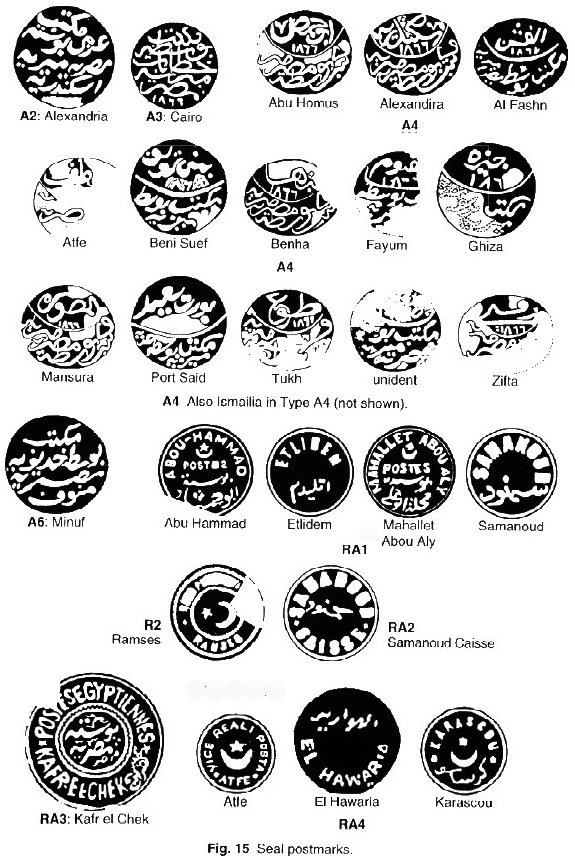 Cash Type Cas These Types include the word CASSA or VAGLIA (Italian), CAISSE (French), CASH10 or C (Fig. 16). They appear to have been used when an item was postmarked at a post office counter (especially on receipts) (Fig. 17). Before about 1880 they are found over-whelmingly on 20-para stamps.Type Cas-1 is known only from a cover in the Byam collection, from Alexandria to France by the French post; it cancels a 20pa. stamp. This stamp should not have been needed, and it paid no applicable rate. Furthermore, Cas-1.5 is known with earlier dates than Cas-1. 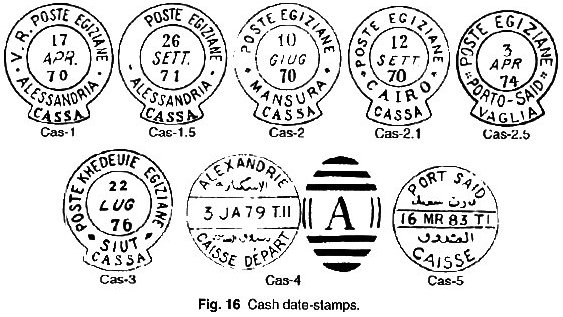 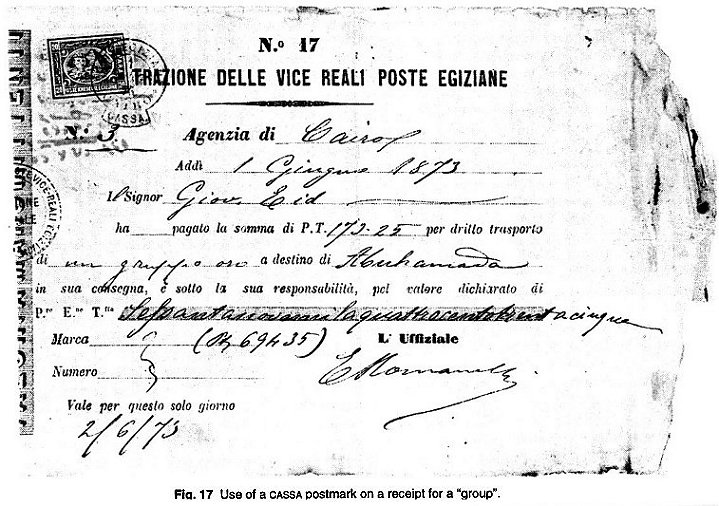 Stations Type Sta These postmarks include the word STAZIONE or STATION (mahatta, xxx and were used at branch post offices at railway stations (Fig. 18). In later years, many additional types beyond those shown here were introduced. 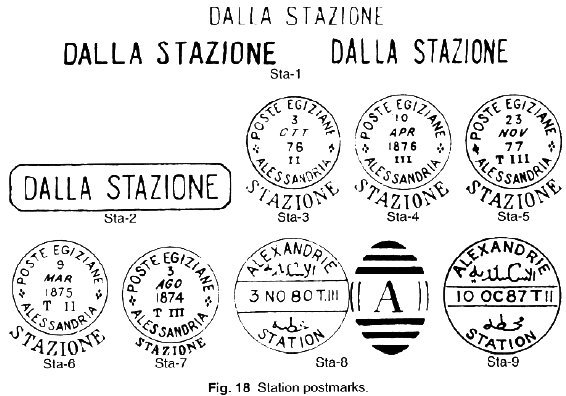 Arrival and Departure11 Types Arr and Dep In the larger offices specially designated date-stamps for and departing mail were put into use. At first they included the full words ARRIVEE (waarid, xxxx or DEPART (ssadir, xxxx ); later the initials were used (Fig. 19). Properly, the arrival markings should have been used as a backstamp of receipt, or as a cancellation for postage due stamps, but sometimes one finds an "arrival" cancellation used on outgoing mail. 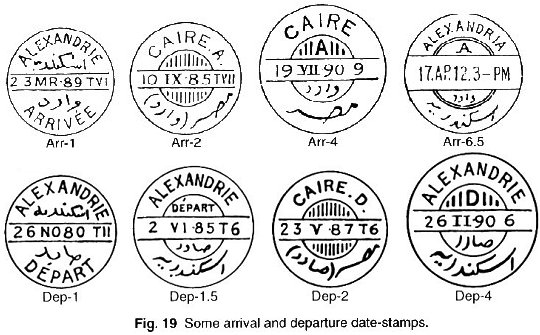 Traveling Post Offices and Sea Post Offices Types TPO and SPO These are taken up in Chapters XXXVII and XXXIL Rural Service Type RPS The postmarks used in 1h0 Kural Postal Service are treated in Chapter XXXVII. Registration Type Reg In the Italian-language period, dateless, straight-line handstamps reading RACCOMANDATO (-A, -P) or PFR CONSEGNA were used on registered letters for information and only adventitiously to cancel stamps (Fig. 20). With tire change to French as the European language, date-stamps were introduced having the word RECOMMANDE(E)S; they were used as cancellations. Later date-stamps for registered mail were identified only by the single letter R (sometimes as R.D. or R.& P). Rectangular R handstamps having space for a number to be entered were not introduced until the late 19th century. Mail that was insured was struck with a straight-line ASSICURATE in the early period; later markings included the word ASSURE or INSURED. 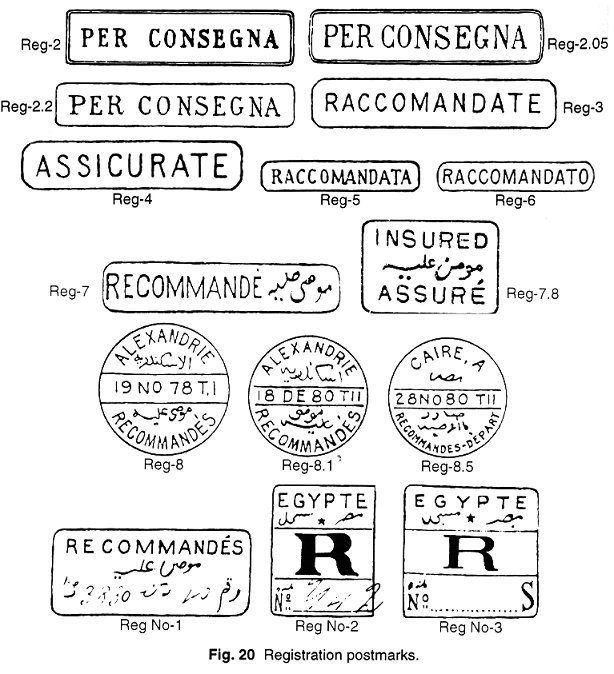 Postal Service Type PS Postal Service handstamps are designated with a PS- number (Fig. 21). They, were used for various administrative purposes within the postal service, and were seldom, if eves, used on mail originating from the public. They are rarely, found on stamps, but occur widely, on interpostal seals. Since they bear no date, the dates of use can only be approximated by means of the issue of interpostal seals on which they are seen. 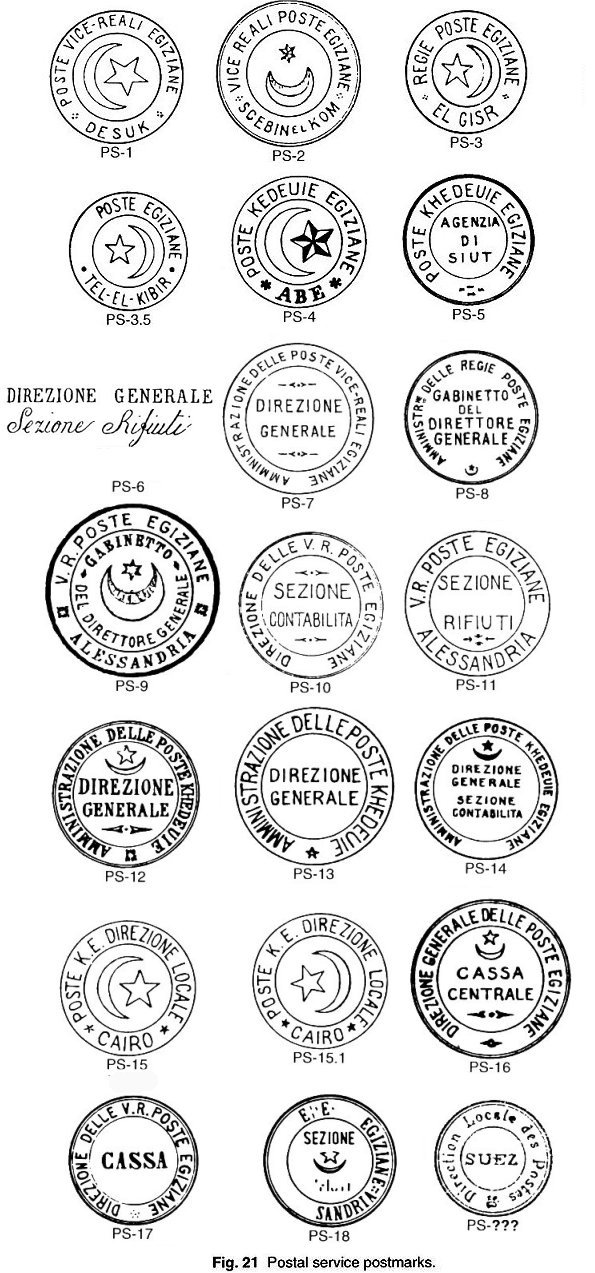 Governmental Offices Type GS For some locations that received a high volume of government mail, special date-stamps were provided (Fig. 22) (Chapter XXIII). The earliest ones, introduced in the 1880s, bore the word GOUVERNMENTALES in addition to the name of the office. 1n later times, a single letter G Was used, usually, accompanied by the Arabic word miri (L ), but sometimes by harbiya xxxx (military) where appropriate. Related to these post offices are those of specific Ministries and governmental organizations, as well as post offices at royal palaces. 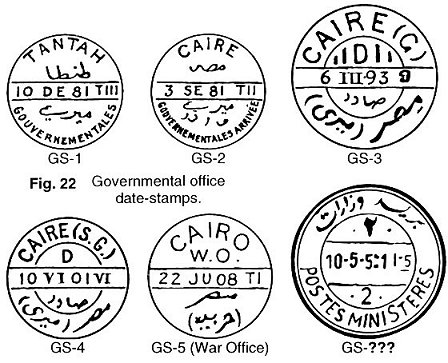 Franca(o) Type Fra This category includes markings worded Franca or Franco (Fig. 23); they were used not only to indicate that postage had been paid, or was not required, but especially to indicate that postage to destination was paid by the stamps applied, where a letter posted at an interior office was to be sent on by a foreign post office, such as the Austrian, with which Egypt had a postal agreement. Type Fra-3 sometimes occurs on stamps, but mostly is on the envelope (also without frame or without xxxx in blue.  Postage Due Types Tax or INP Postage due was indicated by numerals before postage due stamps were issued in 1884 (Chapter XXIV). At first, some offices wrote the numeral(s) in manuscript, but for the most part, handstamped numerals in cursive manuscript style were used. The numerals stood for either paras or piasters, without specific indication, but their was little risk of confusion (e.g., a letter bearing ? piasters postage due would be marked either "?" or °80°). The fact that an item was insufficiently prepaid and was thus liable to postage: due was indicated by a framed handstamp, INP-1 before the inauguration of the UPU, after which a boxed T was generally used (there were some exceptions on internal mail). Air Mail Date-stamps and instructional markings used in connection with air mail are described in Chapter XXV. Handstamps for Undelivered Mail This category includes return-to-sender (ReS), unknown (Unk), unc laimed (Unc), refused (Ref), and Dead Letter Office handstantps. The use of such handstamps is obvious (Fig. 24). None seems to be known from the classic period. Although such markings are normally to be found on envelopes, away from the stamps, postage due stamps were sometimes struck with them.  Advice of Receipt Type AR Advice of receipt; accusé reception. Type AR-1 has been seen cancelling a Third Issue stamp, but no example is known on cover. Type AR-2, however, was widely used to cancel the stamps that paid the AR fee (5m. or 1pi.). On registered letters with the AR fee paid, only the stamps used to pay it were so cancelled, the stamps that paid the postage and registration fees being cancelled with the customary date-stamp (Fig. 25).  Rettas Type B The classic retta, Type B-1, is a diamond composed of 81 diamond-shaped dots with sharp points. Later rettas differ in details of size, shape, and number and form of the dots, but all are mute (Fig. 26). Their initial use was to cancel stamps, the date-stamp being struck on the envelope13. Beginning in about April 1866 this use of the retta was abandoned and the date-stamps were used as obliterators. The rettas thereafter had the function of cancelling stamps that for any reason had not been cancelled at the point of origin. The circumstances included trail received from ships, stamps overlooked at origin (Fig. 27), mail from civilian internment camps in war time, and even stamps that were already cancelled, but too faintly. The retta may be found cancelling non-Egyptian stamps when they were used on board a ship arriving at an Egyptian port. After the classic period many variations on the retta came into use14.  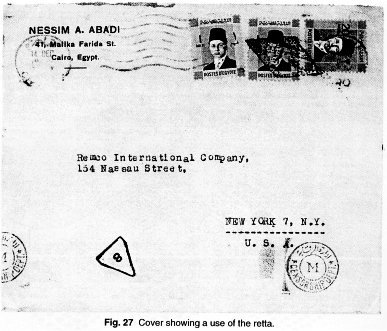 "Invalid" Indication "O" marking15 The UPU regulation for international mail specifics that invalid stamps arc not to be Fig. 28 The "O" to cancelled, but are to have the symbol O (or 0) written or impressed beside them. This system was sometimes also used on internal mail in Egypt. The symbol may be written in pencil or be handstruck; in the latter case, it usually takes the form of O inside a box (Fig. 28). The invalid stamp is usually surrounded by a hand-drawn frame.  Pre-obliteration Properly precancelled stamps were not used in Egypt, but for a short period (1878-79) at Alexandria newspapers applied a kind of security, cancellation by placing the stamp on the newsprint before the paper went through the press (Fig. 29). The stamps used were the 1875 and 1879 5pa. which were so placed as to be imprinted with part of the date-band of the newspaper. Cancellation by a circular date-stamp was still applied. 1878. Fig. 29 Newspaper precancel  After Departure These postmarks are informational straight-line handstatnps indicating that a letter was posted too late to be included in the day's dispatch. There is no evidence that a late fee was charged and the covers (rare) that have been seen are mostly franked at the normal rate. It has been asserted that the handstamps were struck on the stamps before the normal cancellation was applied16; however, they were struck both onthe stamps and oil the envelopes17 The early ones were in Italian, "Dopo la Partenza", but were replaced by French, "Apres Depart", in the 1880s (Fig. 30). ']'here scans to have been extensive forgery. 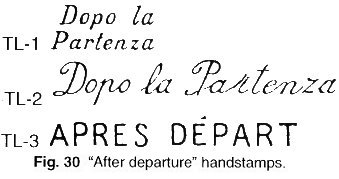 Parcel and Insured Parcel Post near the turn of the century other Types of postal markings were introduced. These include handstamps for parcel post (Pig. 31), the function of which is self-explanatory.  In the first period, the French inscription cobs postaux was included; in the twentieth century, the English word "parcels" was frequently used, or in some cases, the initial "P'" was included in the date-stamp (the Arabic is usually written out: tarood xxxx Since registered letters and parcels were usually handed in over the counter, it became convenient to provide the same postmarker for both; these were usually indicated by the initials "R & P'". Insured parcels sometimes had special postmarks. Money Orders At least as early as 1881, special postmarks for international orders were introduced; they were inscribed in French, mandats internationaux. Later, English was used, and even initials (F.M.O. for Foreign Money Order). 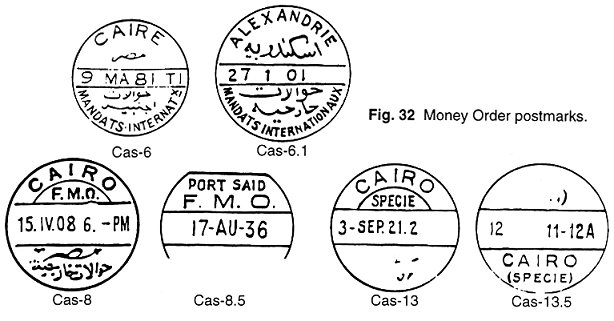 Cash-on-Delivery and Collection-Order18 When services for obtaining payment for parcels on delivery and payment of bills to be remitted to the sender were introduced, special postmarks were sometimes provided. These are usually indicated by the initials C.O.D. and C.O.S., respectively17. 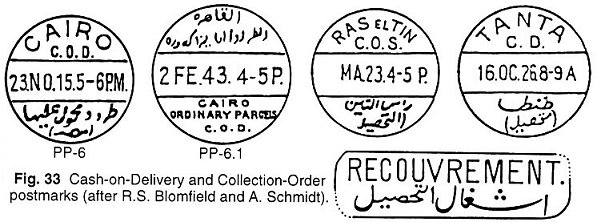 Customs Service These were usually explicitly identified in words, in English or French (douane), or by appropriate initials; they were primarily for use on parcels sent abroad. Date-stamps used at a branch post office in the Customs Office sometimes included the word DRAWBACK. The sender of an exported parcel of manufactured goods, such as cigarettes, was entitled to draw back the duty that had been paid when the raw materials, such as tobacco, were re imported. Since this service was employed almost (?) exclusively for export of cigarettes, the Arabic inscriptions often had the word for tobacco included. 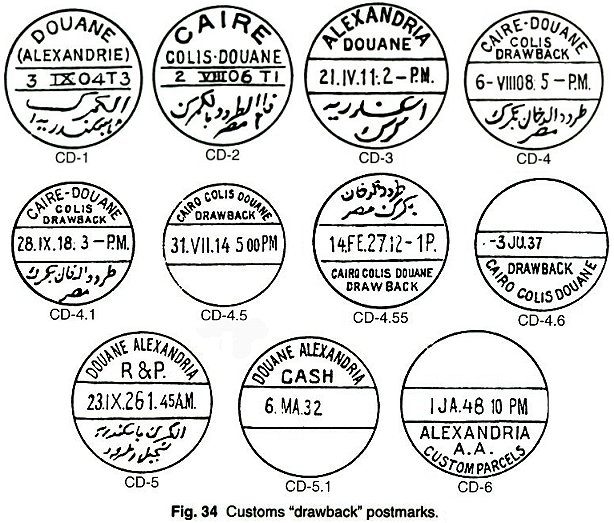 Non-postal date-stamps Some non-postal uses of postage stamps entailed special cancellations. The Children's Savings Bank (épargne scolaire) was a service used in schools, whereby children purchased 5m. stamps, which were placed in a small book. When the book was full, it was turned in for credit to the child's account (Fig. 35). In such cases, the stamps were cancelled with a date-stamp inscribed appropriately in English or French. The Salt Tax (service du sel) was customarily collected at post offices by means of fiscal stamps affixed to special forms. Most offices simply used the ordinary date-stamp for the purpose, but Cairo and Alexandria had special date-stamps inscribed SERVICE DU SEL (Fig. 36).   Auxiliary markings. There were many auxiliary or directional markings besides those already described, such as those for misdirected mail. A selection is illustrated (Fig. 37); their functions are self-explanatory. 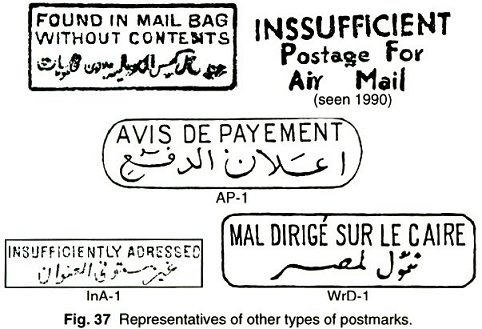 In the list that follows, each post office for which a postal marking in the classic period is known is named, along with each postmark Type that has been recorded for it. At the right are given scarcity factors20, on the basis of I for the commonest, such as most of those of Alexandria, up to 3000 for the very rarest. These numbers are based on a census of the content of some major collections, modified in some instances by ancillary information. In some cases, the scarcity factor is rather uncertain, and may well be much lower than that given; such especially uncertain and tentative factors are enclosed in parentheses. The relative scarcity of each Type within the group for a given office is indicated in parentheses by the letters U (Uncommon), S (Scarce), and R (Rare) (the commonest Types are not rated). The actual scarcity rating would thus be the number for the office suitably enhanced by the rating for the Type. There is more subjectivity in the ratings for the Types than for the offices as a whole. The scarcity factors do not indicate value, which is a composite of scarcity and demand, the latter often predominating. All other things being equal, it generally takes a five- to ten-fold increase in scarcity to double the value. This list is comprised of the internal offices. The offices abroad (consular offices) and in the Sudan (territorial offices) are taken up in Chapter XXIX. For reference, the commonest of them, COSTANTINOPOLI, has a scarcity factor of 12 compared to Alexandria. The dates (year) of opening are in many instances estimated from examples of postmarks recorded. In the cases of the small number of offices that were short-lived, the opening and closing years are given. Note that spellings may vary.
When a temporary post office was set up at the site of a special event (usually a Congress, Exposition, or international sports event), special postmarks were provided. These contained the name of the event as well as the site (mostly Cairo). In addition to the circular date-stamps, registration handstamps were provided in some instances. It should be noted that these postmarks should not be considered to be commemorative postmarks and they were not provided for general commemorative stamp issues (e.g., the Prince Farouk Birthday stamps). On the other hand, in some cases they were provided for events for which commemorative stamps were not issued2l. The earliest example is the Alexandria Exposition of 1894 (Fig. 38). It appears that the public made very little use of the postal facilities except to obtain souvenirs in the form of unaddressed envelopes franked with the 3m. maroon stamp, stocks of which were resurrected for the event. Even these are quite scarce, and covers that actually travelled are rare. 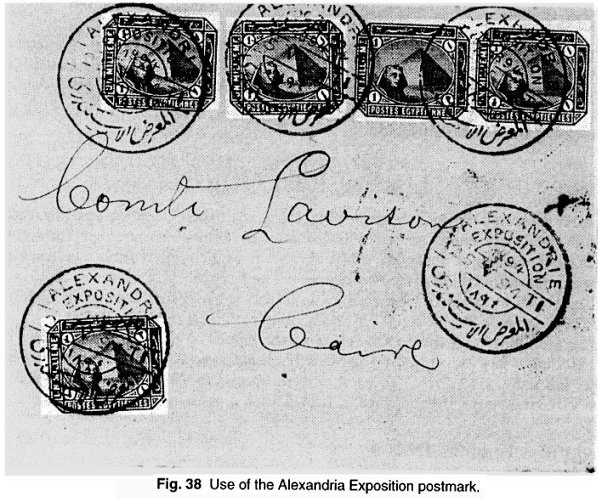 No further instances of postmarks for special events occurred until the Heliopolis Air Meet in 1910; this occasion is treated in Chapter XXIV. The custom of providing special postmarks became established with the Geographical Congress of 1924. Thereafter, such postmarks were consistently provided (Fig. 39); those associated with commemorative stamp issues are illustrated in the Zeheri catalogue. They are usually, but not exclusively, to be found cancelling the corresponding commemorative stamps. None is particularly scarce, as they were used on the large quantity of first-day covers prepared to meet the philatelic demand. However, those prepared for events having no commemorative stamp issue are considerably harder to find. 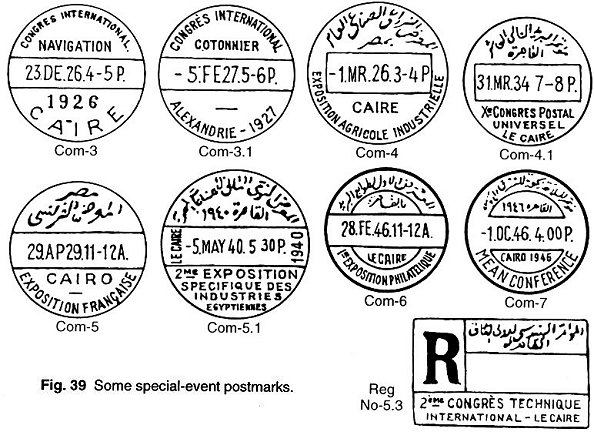 A distinction should be made between the postmarks of post offices established for special events and those provided to designate the first day of issue of stamps. Special first-day cancellations were introduced in 1957 with the National Assembly commemorative stamps; they generally have an undulating circle. Some of these are illustrated in the Zeheri catalogue also. The post offices operating in a given year, along with their classification, are regularly listed in the Postal Guides, generally issued annually. Unfortunately, they are not easily accessible, but some of the major world libraries have incomplete runs. The list of 1953 has been reproduced in L'Orient Philatelique22. The Egyptian post offices up to 1914 have been compiled by Birken23, a special value of this work is that alternative spellings as well as the names in Arabic script are given, along with locations on a map. The following lists, due to Chaftar, give the names of the offices established from 1880 to about 1884 (thus just after the strictly classic period). Since then, the number of offices has increased greatly. Those that were opened in 1880-83 were supplied with Type VIII date-stamps; those opened in 1884-5 were supplied with Type X.
Note that a few additional short-lived offices are known from this period. Most names of Egyptian localities are primarily defined in the Arabic form which must be transliterated into the European alphabet. There is a considerable variety of systems for transliteration and the choice used in Egyptian postmarks has changed over the years. In the early period (to 1877), a somewhat informal version of Italian phonetics was used; thus, SCIRBIN, ROSETTA. However, although the Italian language does not normally use the letters K or W, these letters appear in some names such as SCIBIN EL KOM and MASSAWA. In the middle period a change was made to French phonetics; thus CHERBIN, ROSETTE, CHIBIN EL COM, MASSAOUAH. Beginning about 1906 a change was made to English phonetics or a systematic international method; thus, SHERBIN, SHIBIN or CHIBIN EL KOM. DAMIATA or DAMIETTE became DUMYAT, and ROSETTA or ROSETTE became RASHID. In most cases these changes should not cause confusion, but a few examples were changed drastically, notably TEH EL BAROUD which became ITYAI EL BARUD, GALIUB which became QALIUB, and SCIBIN EL ANATER which became SHIBIN EL QANATER. Before 1906 the date-stamps of many offices included a Roman number, usually preceded by T, to indicate the part of the day or the collection time. In 1906 this practice was changed to one in which a clock time was used, such as "9 30 AM". Dates were at first expressed using abbreviations of the Italian names for the months: GENNAIO, FEBBRAIO, MARZO, APRILE, MAIO, GIUGNO, LUGLIO, AGOSTQ, SETTEMBRE, OTTOBRE, NOVEMBRE, DECEMBRE (in modern Italian, the correct spelling is DICEMBRE, however). Beginning about 1878, newly introduced date-stamps used abbreviations (usually just two letters), of the French names for the months: JANVIER, FEVRIER, MARS, AVRIL, MAI, JUIN, JUILLET, AOUT, SEPTEMBRE, OCTOBRE, NOVEMBRE, DECEMBRE. Concurrently, some date-stamps used Roman numerals for the month.There are several systems for specifying a calendar date in Arabic; they are somewhat complicated by the existence of the Lunar Calendar24 in which a year is shorter than the Solar year of 365 days. Fortunately, in Egyptian date-stamp's that express a date in Arabic, the Lunar Calendar is not generally used and a twelve-month year is expressed with Arabic or arabicized European names. The philatelist's need is essentially confined to Type V-4; the names used are shown in Figure 40. Refrences:
|
|
|